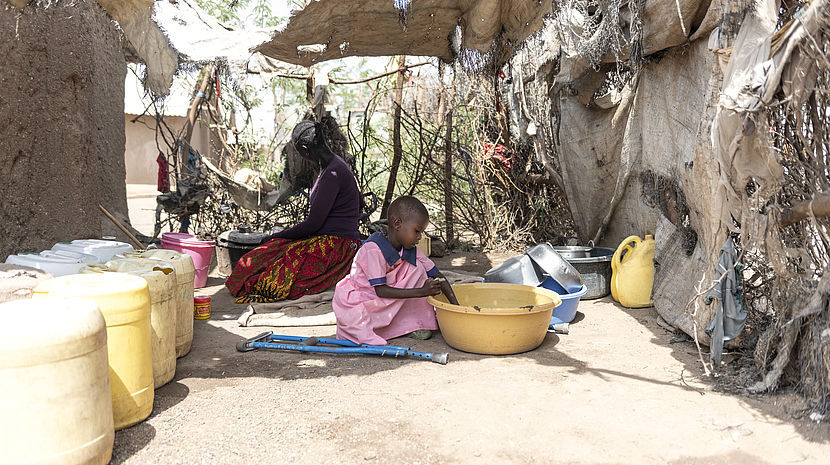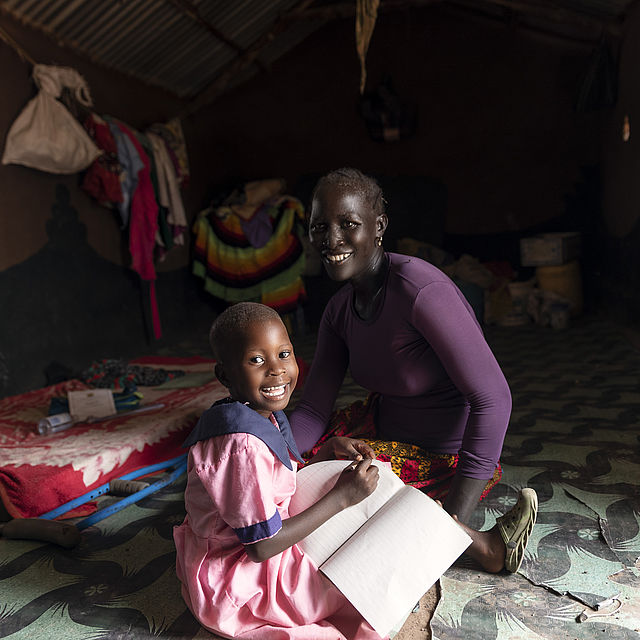Strengthening Inclusive Humanitarian Response for Persons with Disabilities

6-year-old Princess lives in Kakuma Refugee Camp in Turkana, Kenya. Princess' mother fled South Sudan in 2014 during the war.
©CBM
In today's world, the frequency and severity of natural disasters and crises have been on the rise, leaving millions of people in dire need of assistance.
CBM recognizes the importance of responding to these challenges and actively engages in providing humanitarian assistance during conflict-related crises, displacements, and in the aftermath of natural disasters. In part one of this interview, Roland Schlott, Director of CBM's Inclusive Humanitarian Action Initiative (IHA), provides insights into CBM's humanitarian action work.
Q: How does CBM respond to humanitarian crises?
A: CBM is not an immediate crisis responder with an emergency response team. We restrict our operations to areas where we already have a presence, addressing fundamental needs such as food, non-food items, and health care. Our efforts also centre around re-establishing “normality” and social cohesion between displaced individuals and host communities. Additionally, we provide psychosocial support and mental health services for those traumatized by displacement. In Eastern Congo and Cameroon, our partners specialize in physical rehabilitation and prosthetics for individuals who have lost limbs and need rehabilitation.
In Ukraine, we are equipping a hospital ward to address the needs of patients with spinal cord injuries who have been affected by the ongoing conflict. This is a critical humanitarian effort where our focus is not only on acute needs but also on preventing disabilities and removing barriers in humanitarian contexts.
Q: How long does CBM stay involved in humanitarian situations?
A: The duration of our involvement depends on the situation and the needs of the people we address. In some cases, as the situation stabilizes, reconstruction efforts begin, and a stable development context is restored. In prolonged refugee situations, like the Kakuma refugee camp in Kenya where individuals from South Sudan have been residing for two to three decades, we focus on mobilizing resources for long-term support on inclusive education. In the eastern Democratic Republic of Congo, for example, we have continuously alternated between life-saving interventions and strengthening reconstruction and systems for the past 25 years. Our goal is to bridge the gap between humanitarian and development work, facilitating the transition of communities into sustainable development contexts.
Q: Why is it important to include persons with disabilities in humanitarian action?
A: In the past, the needs of persons with disabilities have been overlooked, leaving them more vulnerable in crises. Mistreatment and lack of respect for their rights have been observed, particularly for individuals with intellectual disabilities. Through our partners and organisations of persons with disabilities, we can actively engage in advocacy efforts to enhance the quality of humanitarian response and create a more equitable and respectful environment for persons with disabilities.
Q: What are the specific humanitarian concerns of persons with disabilities in times of crisis and how do you address them?
A: Persons with disabilities face specific concerns, such as a lack of access to early warning messages and evacuation support. For example, in the event of an approaching cyclone, deaf individuals may not receive acoustic early warning messages. To address these concerns, we prioritize disability-inclusion by ensuring that alert systems or people are in place to reach persons with disabilities and - in the response phase – we are providing necessary assistive devices and medications.
In another instance, I vividly recall a case where a group of individuals required medication for psychological conditions in a humanitarian context. During the disruption, the supply chain was severely affected. In our humanitarian action projects, we provide general necessities like food and water as well as the required medications. Additionally, we provide essential assistive devices like wheelchairs, crutches, mobility aids, or prostheses. The inclusion aspect of humanitarian action holds significant importance in our work.
Q: Can you share a memorable encounter with someone from the region where you work?
A: In Niger, we support women suffering from untreated fistula and other reproductive health conditions in areas affected by violence. We arrange transportation for them to quality medical facilities in the capital city, Niamey, covering the costs of necessary procedures. This support, made possible by funding from the BMZ, helps to prevent stigma and rejection of women within their communities. The impact of our assistance is evident not only for individuals but also for entire families when the person gains independence and self-care abilities. It's remarkable how even small actions can make a profound difference, not only for individuals but also for society.
Q: What will be the biggest humanitarian challenges in the future?
A: The global crisis of conflicts, forced displacement and migration, along with natural disasters and climate change, will pose significant challenges. This leads to an increase in injuries and disabilities, demanding assistance from humanitarian workers. What keeps me motivated is the understanding that by addressing specific needs, we empower individuals to regain independence, become active members of their communities, and create a positive ripple effect in society.

A story of hope for this South Sudanese girl born in a refugee camp
Six year old Princess lives with her mother and two siblings in Kakuma refugee camp in Turkana, Kenya. Despite facing the difficulties of life as a refugee born in a foreign country, her love of learning gives her hope that one day she will live an independent life outside the camp. In the Kakuma Refugee Camp, CBM mobilises resources for long-term support on inclusive education.
Born with one leg, Princess considers the Waldorf Kakuma project, supported by CBM, a blessing as it provided her with an artificial leg to enable her go to school. However, when the prosthesis breaks, her mobility is limited. Princess’ mother has to carry her to school. When her mother falls ill, Princess misses school.
Since fleeing war-torn South Sudan in 2014, her mother's journey has been difficult. Providing for the family is a constant struggle with rationed food and no work. But her love for her children transcends these challenges. Princess' mother remains hopeful. The Waldorf project has awakened her optimism because she believes that education can create a better future for her children. She encourages Princess to pursue her passion and emphasises that her disability does not define her. Pride fills her heart when Princess talks about her experience and sings the songs she has learnt from school.
Although Princess is occasionally overwhelmed by the stigma she endures from her peers as a person with a disability, she finds strength in her abilities. “I know that I can do anything I set my mind to. For example, I help my mother fetch water, sweep the house and tidy up,” Princes says.
“Mum thinks I am amazing. That means the world to me. I hope I can help her in the future.”
Get part two of this interview here